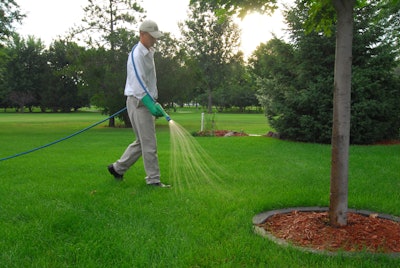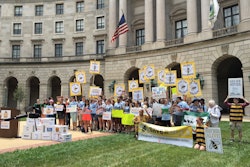 One of the most important parts of pesticide applications is following the label’s instructions.
One of the most important parts of pesticide applications is following the label’s instructions.Photo: Syngenta
In recent years, pesticides have been making quite a splash across the news – and not in a good way.
These chemical control methods have been blamed for every sort of evil imaginable, with the neonicotinoids labeled as the worst of the worst for harming bees. Yet, without these substances, the quality of life we know wouldn’t exist.
So where’s the disconnect? Are pesticides an actual danger? Should the landscape industry move away from using pesticides?
The fact of the matter is, the pesticides that are registered by the Environmental Protection Agency are already intensely scrutinized. Manufacturers can spend anywhere from $250 million to $500 million dollars in bringing a product to market. Part of this expense is related to the numerous toxicological studies that are submitted to EPA for review.
 Frank Wong
Frank Wong“There is a ton of material to walk everyone through the processes involved in registering a pesticide product and the EPA has high standards for ensuring that products do not have a high risk for harm,” said Frank Wong, senior regulatory affairs consultant for Bayer. “But it’s just so much easier to sensationalize a headline that says ‘glyphosate causes cancer.’ It’s a battle we’re always facing. People are looking for “easy” answers. As an industry, we have done a very poor job in effective science communication.”
RISE, or Responsible Industry for a Sound Environment, is one organization that is dedicated to dispelling the myths that surround pesticides. This trade organization represents manufacturers, formulators, distributors and other industry leaders involved with pesticides.
It shares positive information about pesticides with policy makers and monitors the public’s perception toward the chemicals. Surprisingly, despite the volume and visibility of activists’ protests, the majority of the population doesn’t seem to give pesticides much thought, according to RISE’s research.
“Most aren’t thinking about the products,” said Karen Reardon, vice president of public affairs for RISE. “People do have a perception that organic products are as effective as EPA-approved products, but the organic products don’t have to prove they work. Unless there is EPA testing, there is no way to guarantee its effectiveness.”
Sustainability has been considered synonymous with organic products, but, according to Wong, choosing organics over synthetic products on principle could be hurtful in the long run.
“If you start looking through some of the toxicity profiles of some of the “organic” pesticides like azadirachtin (neem oil), you can see it is extremely hazardous to pollinators and bees,” Wong said. “So it’s a false argument that organic is better than synthetic.”
This isn’t to say that organic products are bad. In fact, Syngenta has had success with Heritage fungicide, Acelepryn insecticide, and Tenacity herbicide, which are all naturally derived.
 Stephanie Schwenke
Stephanie Schwenke“Whether a product is naturally or synthetically derived, the key criteria for choosing a product is the combination of efficacy on the target pest and impact of the application on the landscape,” said Stephanie Schwenke, turf market manager for Syngenta. “Syngenta has seen increased interest in products like Acelepryn insecticide.”
According to Schwenke, Acelepryn is capable of controlling grubs all season long, doesn’t require a signal word, has little impact on bees and is registered by the EPA under the agency’s Reduced Risk Program.
However, even the safest of pesticides can have a negative impact if the applications rates are not followed.
“It is absolutely critical for anyone who is applying products to read and follow the label,” Schwenke said. “Before being registered for use, products undergo years of research and development to determine rates and environmental impact. This research is conducted according to the rigorous standards of the EPA. What it comes down to is proper education and training for product applicators to ensure they are following best management practices and products are being used responsibly.”
When products are used incorrectly, the consequences can be monumental and fan the flames of those against the use of pesticides altogether. A noteworthy example of this occurred in 2013, when a landscaping company sprayed blooming linden trees with the insecticide Safari and effectively killed 50,000 bees.
Safari’s active ingredient is neonicotinoid dinotefuran, and it warns on its label that it is toxic to bees and should not be applied to blooming plants.
“The worst thing you want happening is to have uneducated folks out there misusing pesticides, whether it’s organic or synthetic products, and making the wrong decisions. That doesn’t help anybody,” Wong said. “Education, innovation, and certification should all be part of the pesticide conversation. They’re (pesticides) a tool in the toolbox that needs to be used properly and with respect.”
While the public may not recognize it, pesticides are protecting us from a number of pests that harbor deadly diseases. Most people take for granted that their homes are not overrun with ticks and mosquitoes, nor has their family experienced a food shortage due to wide-spread fungus.
“We don’t realize how integral these things have been in providing us a better life,” Wong said. “Say for example you rolled back some of the current technologies available to control mosquitoes. You start having higher rates of malaria, West Nile and Zika virus due to these being vectored by mosquitoes.
“Do we really want to wait to that point in time before people realize the value of some of these control technologies?”









